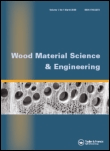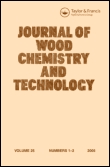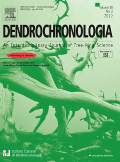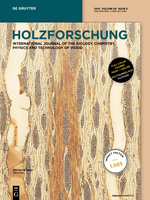
IAWA JOURNAL
Scope & Guideline
Shaping the Future of Forestry Research
Introduction
Aims and Scopes
- Wood Anatomy and Structure:
Research exploring the anatomical features of wood, including cellular composition, growth rings, and vascular systems, emphasizing the relationship between structure and function in different species. - Ecological and Environmental Studies:
Investigations into how wood anatomy reflects ecological adaptations and environmental changes, including studies on the impact of climate on wood properties and tree growth. - Fossil Wood and Paleobotany:
Exploration of fossilized wood specimens to understand historical biodiversity, evolution of plant species, and geological contexts, contributing to our knowledge of ancient ecosystems. - Technological Innovations in Wood Analysis:
Development and application of advanced imaging and analytical techniques for wood identification and characterization, enhancing methodologies in wood science. - Cultural and Historical Aspects of Wood Use:
Studies examining the historical significance of wood in human societies, including traditional uses, cultural practices, and the impact of wood on historical records.
Trending and Emerging
- Impact of Climate Change on Wood Properties:
There is an increasing focus on how climate variables, such as temperature and precipitation, affect wood growth and anatomical adaptations, reflecting global concerns over climate change. - Functional Wood Anatomy:
Research is trending towards understanding the functional significance of wood traits, such as hydraulic efficiency and drought resistance, which are critical for predicting tree survival under changing environmental conditions. - Interdisciplinary Approaches:
Emerging studies are increasingly incorporating methods from other disciplines, such as molecular biology and ecology, to provide a more comprehensive understanding of wood biology and its applications. - Technological Advancements in Imaging Techniques:
The use of advanced imaging techniques, including X-ray micro-CT and 3D modeling, is on the rise, enabling more detailed investigations of wood structure and facilitating innovative research methodologies. - Wood in Sustainable Practices:
There is a growing interest in the role of wood in sustainable forestry practices and its applications in eco-friendly materials, emphasizing the importance of wood science in addressing environmental sustainability.
Declining or Waning
- Traditional Wood Identification Methods:
While wood identification remains important, papers focusing on conventional techniques have decreased as researchers increasingly adopt advanced methodologies such as spectroscopy and imaging technologies. - Basic Descriptive Anatomy:
There has been a noticeable decline in studies that solely describe wood anatomical features without linking them to broader ecological or functional implications, as the field moves towards integrative approaches. - Historical Wood Studies:
Research centered on historical wood uses and cultural significance has become less frequent, possibly due to a shift towards more pressing ecological and environmental issues. - Narrow Taxonomic Focus:
Papers concentrating on a limited number of species or genera have waned, indicating a trend towards broader comparative studies that encompass wider taxonomic groups.
Similar Journals

Wood Material Science & Engineering
Crafting a Sustainable Future with Wood ScienceWood Material Science & Engineering, published by Taylor & Francis Ltd, is a pivotal journal in the field of materials science, focusing specifically on the intricate properties, performance, and applications of wood-based materials. With an ISSN of 1748-0272 and an E-ISSN of 1748-0280, this journal has established itself as a valuable resource for researchers and professionals working in the interdisciplinary domains of material science and engineering related to wood. Since its inception in 2006, the journal has seen continual growth, with its 2023 Scopus Rank placing it in the 49th percentile among general materials science journals. Although listed in Q3 of the materials science category, it plays a crucial role in facilitating innovative research and applications of wood materials, thereby significantly influencing sustainable practices in engineering and design. The journal invites original research articles, reviews, and case studies to further the understanding of wood materials, making it an ideal platform for scholars and practitioners dedicated to advancing material science. For researchers looking to disseminate their findings to a global audience, Wood Material Science & Engineering promises a dedicated avenue for impactful communication.

Scientia Forestalis
Exploring the depths of forest ecosystems and their complexities.Scientia Forestalis is a prominent academic journal dedicated to advancing the field of forestry and environmental studies. Established in 1996 and published by the Instituto de Pesquisa e Estudos Florestais (IPEF) in Brazil, this journal provides a critical platform for researchers and practitioners to disseminate innovative studies and findings in forestry. With an HIndex reflective of its academic impact and ranking in the third quartile of forestry journals, Scientia Forestalis is positioned to cater to a diverse audience, including scholars, professionals, and students engaged in agricultural and biological sciences. Despite its non-open access model, the journal maintains a commitment to high-quality research that fosters an understanding of forest ecosystems and sustainable practices. Published articles span a wide range of topics, ensuring that crucial developments in forestry science are captured and shared. The journal's current Scopus rank places it within the 26th percentile, affirming its role in shaping forestry research in a global context, making it an essential resource for anyone interested in this vital field.

Maderas-Ciencia y Tecnologia
Connecting researchers to shape the future of forestry.Maderas-Ciencia y Tecnologia, published by UNIV BIO-BIO in Chile, is a prestigious open-access journal dedicated to advancing knowledge in the fields of Forestry, Chemical Engineering, and Materials Science. With an ISSN of 0717-3644 and an E-ISSN of 0718-221X, this journal has been serving the academic community since 2005, providing a platform for research that spans multiple disciplines including Industrial and Manufacturing Engineering. Recognized for its scholarly contributions, Maderas-Ciencia y Tecnologia achieves a commendable Q2 ranking in Forestry and several Q3 rankings in associated fields such as Chemical Engineering and Materials Science as of 2023. The journal aims to foster innovation and collaboration by publishing high-quality research articles that address pressing issues in wood engineering and technology, appealing to researchers, professionals, and students alike. With a strong commitment to open access, all content is readily available to a global audience, ensuring the widespread dissemination of knowledge and fostering advancements within these critical areas.

WOOD SCIENCE AND TECHNOLOGY
Transforming Wood Science for a Sustainable FutureWOOD SCIENCE AND TECHNOLOGY, published by SPRINGER, is a premier academic journal dedicated to the multidisciplinary study of wood and its applications. With a rich history spanning since its inception in 1967 and continuing through 2024, this journal plays a vital role in advancing our understanding of forestry, industrial and manufacturing engineering, and materials science. It enjoys an impressive categorization in the 2023 rankings, securing a Q1 status in Forestry and notable Q2 rankings in Industrial and Manufacturing Engineering, Materials Science, and Plant Science. Researchers and professionals benefit from its rigorous peer-reviewed articles, making substantial contributions to the field. The journal is actively indexed, ensuring high visibility and access to its content, which is essential for anyone looking to stay at the forefront of wood science research. The current impact factors and rankings affirm its significance, making it a critical resource for academics seeking to foster innovation and collaboration in wood technology and related disciplines.

TREES-STRUCTURE AND FUNCTION
Innovating research to protect our global forests.TREES - STRUCTURE AND FUNCTION, published by Springer Heidelberg, is a leading journal dedicated to advancing the scientific understanding of tree biology through rigorous research and interdisciplinary approaches. With an impressive impact factor reflecting its high visibility in the scholarly community, this journal specializes in various aspects of tree ecology, physiology, and structure, making it a vital resource for researchers, professionals, and students engaged in forestry and environmental sciences. The journal holds notable rankings, placing it in the top quartiles of several categories, including Q1 in Forestry and Q2 in Ecology as of 2023, underscoring its relevance and influence in the field. Although it is not an open-access journal, TREES strives to disseminate critically important findings that contribute to our understanding of global forest ecosystems and their role in climate change mitigation. With a publication history spanning from 1986 to 2024, this journal continues to shape the future of tree research, providing a platform for innovative studies that inform policy, conservation, and sustainable practices.

JOURNAL OF WOOD CHEMISTRY AND TECHNOLOGY
Enhancing Material Development with Wood Chemistry InsightsJournal of Wood Chemistry and Technology, published by Taylor & Francis Inc, is a premier academic platform dedicated to advancing the fields of wood chemistry and technology since its inception in 1981. With an impressive converged publication run extending through 2024, this journal addresses pivotal research in chemical engineering and materials science, achieving a current categorization in Q2 for both Chemical Engineering and Chemistry, alongside a Q3 ranking in Materials Science. As evidenced by its Scopus rankings, it occupies a respectable position within the academic community, fostering discussions that bridge theoretical innovation and practical applications relevant to the industry. While access is not open, the journal remains an essential resource for researchers, professionals, and students eager to explore the complexities of wood chemistry, enhancing their understanding and contributing to sustainable practices in materials development.

CANADIAN JOURNAL OF FOREST RESEARCH
Connecting researchers to the heart of forest science.Canadian Journal of Forest Research (ISSN: 0045-5067, E-ISSN: 1208-6037), published by Canadian Science Publishing, stands as a leading platform for disseminating cutting-edge research in the field of forestry and ecological sciences. With an impressive impact factor and a steady reputation for high-quality publications, this journal occupies a prestigious position indicated by its Q1 ranking in Forestry and Q2 in Ecology as of 2023, alongside commendable placements in global and planetary change studies. Covering a broad scope from sustainable forest management to the impacts of climate change on forest ecosystems, the journal encourages submissions that address contemporary challenges and innovations in forest research. Operating from its base in Ottawa, Canada, the Canadian Journal of Forest Research has been a cornerstone of academic discourse since 1974, offering researchers and professionals vital access to pioneering studies that inform policy and practice in forestry. Researchers, educators, and students alike will find this journal an indispensable resource for advancing knowledge and fostering collaboration in the vital realm of forest research.

DENDROCHRONOLOGIA
Illuminating Environmental Change One Ring at a TimeDendrochronologia is a prestigious journal dedicated to the study of tree rings and their implications for understanding environmental changes, climate variability, and ecological dynamics. Published by Elsevier GmbH in Germany, it has consistently reached high academic standards, holding a remarkable Q1 ranking in both Ecology and Plant Science as of 2023, demonstrating its significant impact within these fields. The journal aims to foster interdisciplinary dialogue through the dissemination of original research, reviews, and methodological advancements related to dendrochronology, appealing to researchers, students, and professionals who seek to deepen their knowledge of the interactions between terrestrial ecosystems and climate change. Although it does not currently offer an open access option, Dendrochronologia remains an essential resource for those in the scientific community, with valuable insights that contribute to the understanding of biodiversity and ecological resilience.

HOLZFORSCHUNG
Championing the study of wood as a vital biomaterial.HOLZFORSCHUNG is a distinguished journal in the field of biomaterials, published by WALTER DE GRUYTER GMBH and based in Berlin, Germany. With an ISSN of 0018-3830 and an E-ISSN of 1437-434X, this journal has been a key player in advancing the understanding of wood research and its applications since its inception in 1947. As of 2023, it holds a Q3 ranking in the biomaterials category, positioned at #77 out of 137 in Scopus, reflecting its growing reputation within the academic community. Although it does not currently offer open access, HOLZFORSCHUNG aims to bridge the gap between theoretical research and practical applications, providing valuable insights for researchers, professionals, and students alike. With a focus on innovative studies and contributions to the understanding of wood as a biomaterial, it remains integral to the discourse in materials science.

JOURNAL OF TROPICAL FOREST SCIENCE
Cultivating Insights for Tropical Forest SustainabilityThe JOURNAL OF TROPICAL FOREST SCIENCE, published by the FOREST RESEARCH INST MALAYSIA, serves as a vital platform for disseminating research focused on tropical forestry. Since its inception in 1988 and transitioning to its current form in 1993, this journal has established itself within the academic community, currently holding a commendable Q3 ranking in the Forestry category, as per the 2023 metrics. With an ISSN of 0128-1283 and E-ISSN 2521-9847, it provides crucial insights into the ecological, economic, and social aspects of tropical forest management and conservation, making it an indispensable resource for researchers, practitioners, and students alike. Although it does not operate under an open-access model, the journal emphasizes quality and relevance in its publications, contributing significantly to the ongoing discourse in agricultural and biological sciences with a Scopus rank of #89 out of 174 and a 49th percentile position.